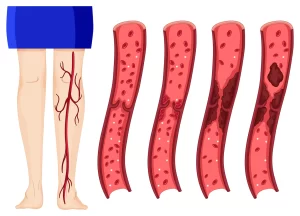 Deep Vein Thrombosis (DVT) is a serious medical condition that can be life-threatening if not promptly recognized and treated.
Deep Vein Thrombosis (DVT) is a serious medical condition that can be life-threatening if not promptly recognized and treated.
It occurs when a blood clot forms in one of the deep veins, typically in the legs or pelvis.
While DVT may seem innocuous at first, it carries significant risks that demand our attention and understanding.
The Silent Onset
DVT can develop gradually, often without any noticeable symptoms in its early stages. As the clot obstructs blood flow, swelling and pain may emerge, but they are often mistaken for simple muscle strain or fatigue.
This silent onset can lead to delays in seeking medical attention, allowing the clot to grow and potentially dislodge, causing a dangerous complication known as a pulmonary embolism.
A Dangerous Traveller
The most perilous aspect of DVT is the potential for the blood clot to dislodge from the site of its origin and travel through the bloodstream to the lungs. Once in the lungs, it can block one of the pulmonary arteries, causing a pulmonary embolism.
This condition can be fatal, leading to sudden shortness of breath, chest pain, and even death.
Factors That Increase the Risk
Several factors can increase an individual’s risk of developing DVT. Sedentary lifestyles, prolonged immobility during long journeys, and bed rest after surgery are common risk factors.
Additionally, certain medical conditions such as cancer, heart disease, and obesity, as well as hormone replacement therapy or birth control pills containing estrogen, can elevate the risk.
The Clotting Culprit
DVT often occurs due to a condition known as Virchow’s triad: alterations in blood flow, vessel wall damage, and increased blood clotting. These factors can arise from injury, inflammation, or circulatory problems.
Understanding this triad helps us recognize the importance of preventative measures and early detection.
Detecting DVT
Diagnosing DVT requires a combination of clinical evaluation and imaging tests. Ultrasound is a common method used to visualize blood clots and assess blood flow in affected areas.
Timely diagnosis is crucial to initiate appropriate treatment and reduce the risk of complications.
Preventive Measures
Prevention plays a significant role in reducing the incidence of DVT. Staying physically active, especially during prolonged periods of sitting or bed rest, is essential. Compression stockings can improve blood flow in the legs, while frequent leg movements and exercises can also aid in reducing the risk.
Deep Vein Thrombosis might not always present obvious warning signs, making it a potentially dangerous and life-threatening condition. If you suspect DVT, seek immediate medical attention to ensure prompt diagnosis and intervention.
Picture Credit: Freepik
